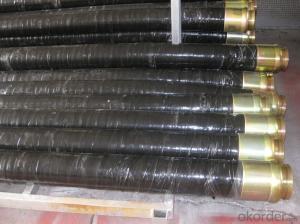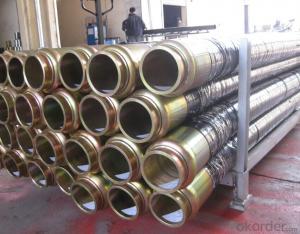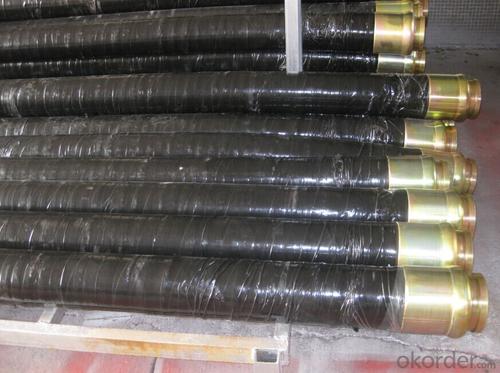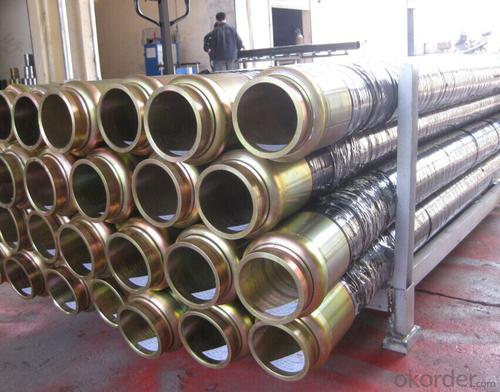Rubber End Hose with Two Side Coupling Working Presure 85 BAR 5M*DN125
- Loading Port:
- Shanghai
- Payment Terms:
- TT or LC
- Min Order Qty:
- 10 pc
- Supply Capability:
- 5000 pc/month
OKorder Service Pledge
OKorder Financial Service
You Might Also Like
Specifications
Name | Specifications | Application | Flange diameter | Remarks |
Rubber hose | DN125*3000 | Concrete pump | 148/DN157mm | |
Rubber hose | DN150*3000 | Concrete pump | 148/DN157mm | |
High pressure | DN125*3000 | Concrete pump | 148/DN157mm | Two layers of steel wire |
High pressure | DN125*3000 | Concrete pump | 148/DN157mm | Four layers of steel wire |
High pressure | DN125*4000 | Concrete pump | 148/DN157mm | |
High pressure | DN150*3000 | Concrete pump | 175mm | |
| DN80*5000 | Mortar pump mini conctete pump | 98mm | |
| DN80*6000 | Mortar pump mini conctete pump | 98mm | |
| DN100*5000 | Mortar pump mini conctete pump | 124mm | |
| End hose | DN65*8000 | Mortar pump | 8m |
Product Description:
The rubber end hose with two side couplings, normally the hoes is made by NR and reinforced by four layer steel wire, and the two couplings at each side are made by steel material No.ST52, 20#, 37MN5, with hot treatment according to customer’s requests, and also package in bundles or nude packing directly put into container.
Inspection & claim: quality should be in conformity with the specification of the manufacturer. Quantity and packing conditions should be in conformity with the term in this contract. Should the quality found not in conformity to the specification of manufacturer, or should the inspected quantity found in shortage, or should the packing found damaged, the buyer has the right to claim to the seller. the claim, if any, should be presented to seller within 30 days after cargo's arrival date to the port, together with related inspection report and photos issued and provided by a reputable independent surveyor such as sgs.
Scope of Application of the hose
The rubber end hose is a concrete delivery for combined use with other concrete pipelines in concrete placement operations. It can be widely used in the construction of various types of concrete structures like industrial and civil buildings, bridges, roads, and other types of infrastructure.
Product Advantages:
OKorder's rubber end hose Channels are durable, strong, and safety. We are the biggest group in this business filed and the majority resources are under our control, which is make sure the delivery time and qualified products, meanwhile we have more than 20 overseas branches our people will go to visit customer very fast for more convenient communication.
Governing law and disputes resolution: this contract is governed by the law of the people's republic of china. any dispute arising out of connection or in connection with the sales contract, including disputes on its conclusion, binding effect, amendment and termination, shall be settled through friendly negotiation. in case no settlement can be reached, the dispute shall be resolved by china international economic and trade arbitration commission (cietac), to the exclusion of the ordinary courts by an arbitral tribunal in accordance with the arbitration rules of cietac without recourse to the ordinary courts of law. Such arbitration shall be final and binding upon both parties. the arbitration fees,unless otherwise awarded shall be borned by the losing party.
Main Product Features:
· Premium quality
· Prompt delivery & seaworthy packing (5-10 days)
Reliable performance
Easy to weld
High safety.
· Professional Service
FAQ:
Q1: How long about delivery time?
A1: Normally we keep the raw materials for old customers and sometime we also keep stock products to make sure delivery time in any emergency cases.
Q2: How do we guarantee the quality of our products?
A2: We have established an advanced quality management system which conducts strict quality tests at every step, from raw materials to the final product. At the same time, we provide extensive follow-up service assurances as required.
Q3: How soon can we receive the product after purchase?
A3: Within three days of placing an order, we will book the vessel for goods. The specific shipping date is dependent upon international and government factors, but is typically 7 to 30 workdays.
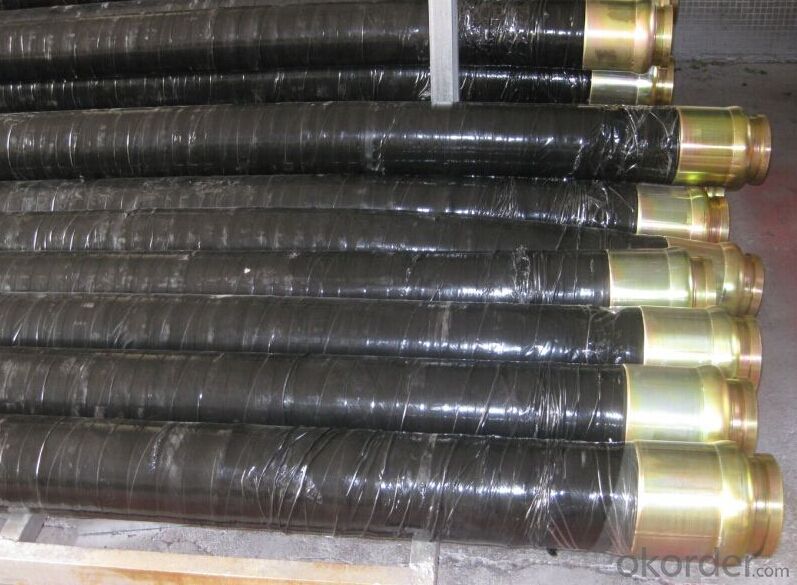
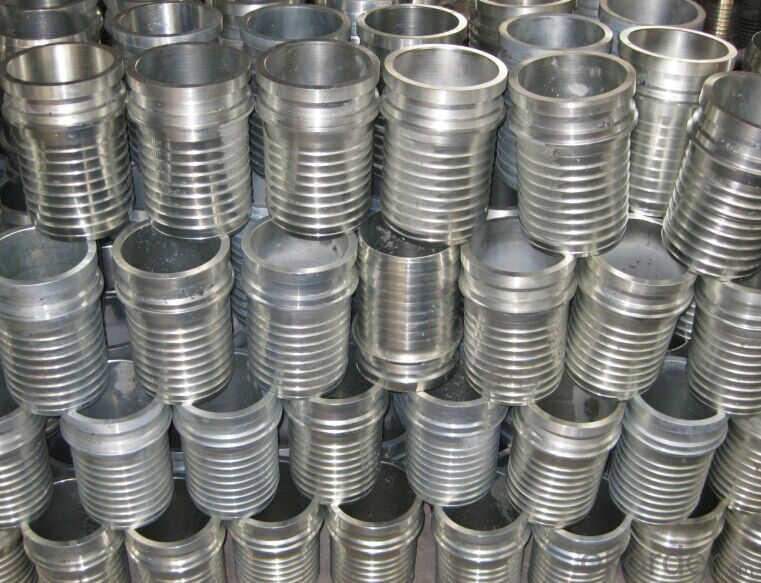
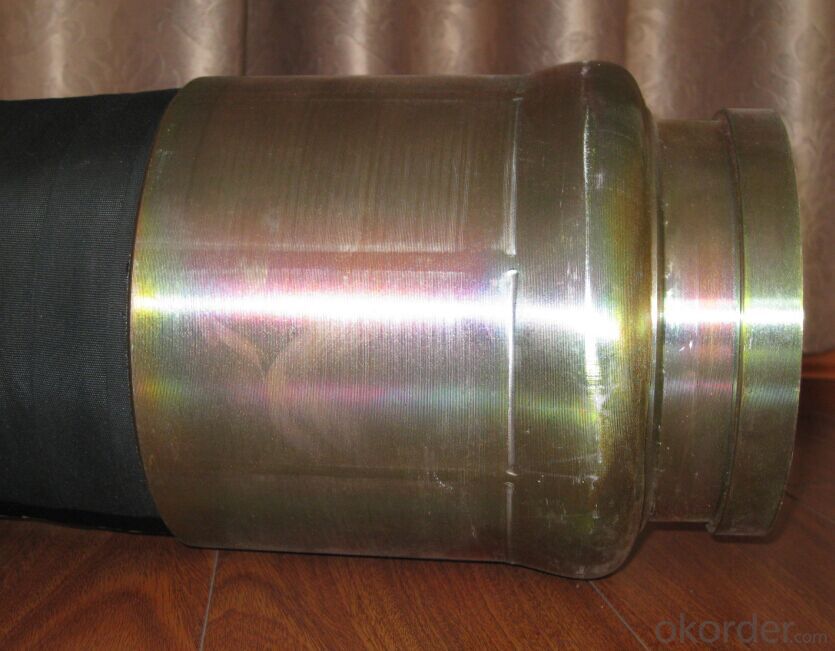
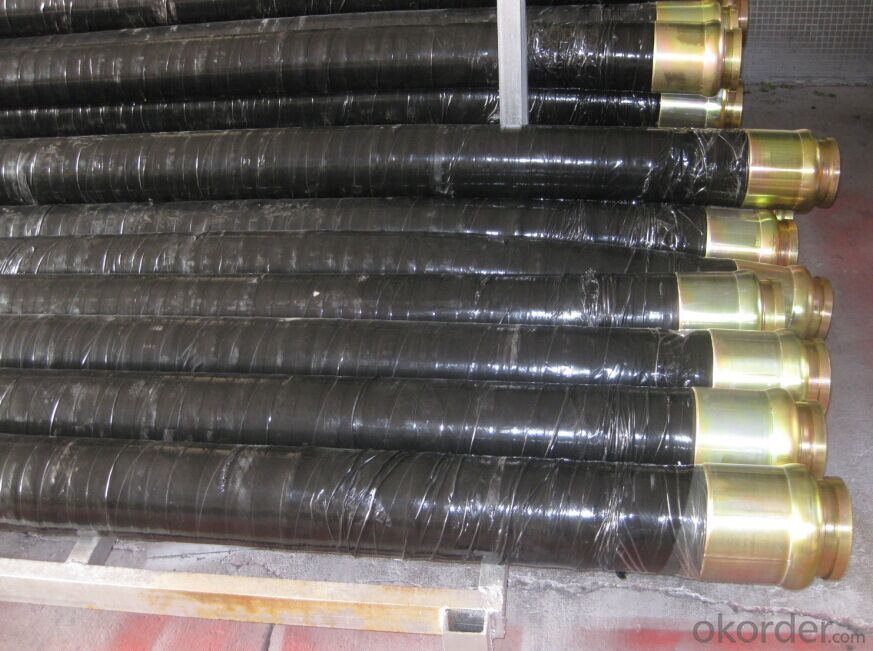
- Q: What are the specifications for concrete delivery pumps?
- In the hot season construction, concrete pump to prevent the oil temperature is too high. When the temperature reaches 70 degrees, stop running or take other measures to cool down;
- Q: Can I get spare parts for both concrete pumps with and without boom stabilizers?
- Yes, spare parts are available for both concrete pumps with and without boom stabilizers. When it comes to concrete pumps, manufacturers typically offer a wide range of spare parts to ensure the longevity and smooth operation of their equipment. These spare parts can include hydraulic components, valves, hoses, seals, wear plates, pipes, and many others. Whether your concrete pump has a boom stabilizer or not, you can easily find and purchase spare parts from the manufacturer or authorized dealers. Additionally, there are also aftermarket suppliers who specialize in providing spare parts for various concrete pump models. So, regardless of the specific features of your concrete pump, you can rest assured that spare parts are readily available to keep your equipment running smoothly.
- Q: What is the farthest pumping distance of concrete pump truck?
- Concrete pump truck, according to the length of the pump boom to determine the pumping height, usually the last 2 arm combination pumping
- Q: Are there any specific guidelines for the installation of control valves or solenoids in concrete pump spare parts?
- Yes, there are specific guidelines for the installation of control valves or solenoids in concrete pump spare parts. Here are some general guidelines to consider: 1. Compatibility: Ensure that the control valves or solenoids you are installing are compatible with the concrete pump spare parts. Check the manufacturer's specifications and guidelines for the appropriate model and size. 2. Proper Positioning: Install the control valves or solenoids in a position that allows for easy access and maintenance. It should be easily visible and reachable for any adjustments or repairs. 3. Mounting: Securely mount the control valves or solenoids to prevent any vibrations or movements during operation. This will ensure the stability and longevity of the components. 4. Electrical Connections: Follow the electrical wiring instructions provided by the manufacturer. Make sure to connect the control valves or solenoids to the appropriate power source and ensure proper grounding to prevent any electrical hazards. 5. Sealing: Apply appropriate sealing materials, such as gaskets or O-rings, to ensure a tight and leak-free connection between the control valves or solenoids and other components. This will prevent any fluid or air leakage. 6. Testing: After installation, it is essential to thoroughly test the functionality of the control valves or solenoids. Check for any leaks, proper operation, and responsiveness to control signals. Any issues should be addressed and resolved before putting the concrete pump into operation. It is important to note that these guidelines are general and may vary depending on the specific manufacturer's recommendations and the design of the concrete pump spare parts. Always refer to the manufacturer's guidelines and instructions for the specific control valves or solenoids being used.
- Q: How can a malfunctioning hydraulic motor affect the pumping process?
- A malfunctioning hydraulic motor can have various negative effects on the pumping process. Firstly, it can result in a decrease in pumping efficiency. The hydraulic motor is responsible for converting the hydraulic energy into mechanical energy, which drives the pumping mechanism. If the motor is malfunctioning, it may not be able to generate enough power to operate the pumping system effectively, leading to a decrease in the volume or pressure of the pumped fluid. Additionally, a malfunctioning hydraulic motor can cause an increase in energy consumption. Inefficient or faulty motor operation can lead to higher energy requirements to maintain the desired pumping rate. This increased energy consumption can result in higher operating costs and reduced overall system performance. Furthermore, a malfunctioning hydraulic motor can lead to irregular pumping or complete pump failure. If the motor is not functioning properly, it may result in intermittent or inconsistent pumping, causing fluctuations in the flow rate or pressure of the pumped fluid. In extreme cases, the motor may completely stop working, leading to a total loss of pumping functionality. Moreover, a malfunctioning hydraulic motor can cause increased wear and tear on the entire pumping system. The motor's improper operation can create excessive vibration or heat, leading to premature failure of other components such as seals, bearings, or pistons. This can result in frequent maintenance or repair requirements, leading to increased downtime and costs. In summary, a malfunctioning hydraulic motor can have significant negative impacts on the pumping process, including decreased efficiency, increased energy consumption, irregular pumping or complete pump failure, and increased wear and tear on the system. It is crucial to regularly inspect and maintain hydraulic motors to ensure their proper functioning and avoid potential issues that may disrupt the pumping process.
- Q: How do I properly maintain and replace filters in concrete pump spare parts?
- To ensure optimal performance and longevity of your equipment, it is crucial to properly maintain and replace filters in concrete pump spare parts. Here are some guidelines to follow: 1. Get familiar with the different types of filters: Concrete pumps have various filters for hydraulic oil, fuel, air, and water. Take the time to understand which filters are used in your equipment. 2. Consult the manufacturer's instructions: Read the equipment manual and adhere to the guidelines provided by the manufacturer regarding filter maintenance and replacement intervals. This will ensure that you are following the recommended practices. 3. Conduct regular filter inspections: Periodically check the filters for signs of damage, clogging, or excessive debris accumulation. You can visually inspect them or measure the pressure differential across the filter. If the pressure differential exceeds the recommended limit, it may be necessary to replace the filter. 4. Clean or replace filters as required: If the filters are clogged or dirty, they should be cleaned or replaced. Some filters can be cleaned by blowing compressed air in the opposite direction of the airflow to remove debris. However, it is important to note that certain filters are disposable and cannot be cleaned. 5. Use authentic spare parts: When replacing filters, always opt for genuine spare parts recommended by the manufacturer. This ensures compatibility and performance. 6. Follow proper handling and installation procedures: When installing new filters, make sure to handle them with clean hands or wear gloves to prevent contamination. Follow the correct installation procedure, such as tightening the filter housing to the recommended torque value. 7. Maintain a regular maintenance schedule: Establish a consistent schedule for filter inspection, cleaning, and replacement. This will help you stay on top of filter maintenance and prevent potential issues caused by dirty or clogged filters. By adhering to these steps, you can effectively maintain and replace filters in concrete pump spare parts, ensuring efficient equipment operation and an extended lifespan.
- Q: How often should hopper grate pin retainers be inspected or replaced in a concrete pump?
- Hopper grate pin retainers in a concrete pump should be inspected regularly, ideally on a monthly basis, to ensure their proper functioning and prevent any potential issues. However, the frequency of inspections may vary depending on the specific conditions of use and the manufacturer's recommendations. During these inspections, it is essential to check for any signs of wear, damage, or corrosion on the hopper grate pin retainers. If any of these issues are detected, immediate replacement is necessary to maintain the efficiency and safety of the concrete pump. Additionally, it is crucial to adhere to the manufacturer's guidelines regarding the lifespan of the hopper grate pin retainers. Some manufacturers may recommend replacing them after a certain number of operating hours, while others may suggest replacement based on the visual condition during inspections. Regular inspections and timely replacement of hopper grate pin retainers are crucial to prevent potential malfunctions or accidents during concrete pumping operations. It is always recommended to consult the concrete pump's manual or contact the manufacturer for specific guidelines regarding the inspection and replacement intervals for hopper grate pin retainers.
- Q: What are the different types of concrete pump hopper agitator motors?
- There are generally two types of concrete pump hopper agitator motors: electric motors and hydraulic motors. Electric motors are powered by electricity and are commonly used in smaller and portable concrete pumps. Hydraulic motors, on the other hand, are driven by hydraulic power generated by the concrete pump itself and are typically used in larger and stationary concrete pumps.
- Q: What is the role of a concrete pump hopper vibrator?
- The smooth and efficient flow of concrete through the pump system is ensured by the concrete pump hopper vibrator. Typically, the vibrator is attached to the hopper, which is the container holding the concrete mixture. To break up any air pockets or clumps in the concrete, the vibrator creates high-frequency vibrations. This allows the concrete to flow freely through the pump and out of the nozzle. Proper vibration is essential, as unclogged or unblocked concrete prevents delays and inefficiencies in construction. Not only does the hopper vibrator facilitate concrete flow, but it also enhances the overall concrete quality. By eliminating air pockets and ensuring a smooth, consistent flow, the vibrator reduces the risk of voids or weak spots in the finished structure. In conclusion, the concrete pump hopper vibrator plays a crucial role in ensuring successful and efficient concrete pumping, while also improving the quality of the final product.
- Q: What are the different types of concrete pump hopper screens?
- There is a wide range of hopper screens available for concrete pumps, each designed to meet specific needs and requirements. 1. The wire mesh screen is the most commonly used type. It is made of woven wire mesh and prevents large debris or aggregates from entering the pump system. These screens come in various sizes and can be easily replaced when worn or damaged. 2. Perforated plate screens are made of solid metal plates with small holes or perforations. They are particularly effective in preventing fine particles or sediments from entering the pump system. Perforated plate screens are more durable than wire mesh screens and can withstand heavy-duty applications. 3. Polyurethane screens are made of polyurethane material, which has excellent resistance to abrasion and wear. These screens are commonly used in high-performance concrete pumps that handle abrasive materials. They are highly durable and can be easily cleaned or replaced when necessary. 4. Some concrete pump hoppers are equipped with a vibrating screen, which separates and removes solids or debris from the concrete mixture. The vibrating screen uses vibration to facilitate the separation process, ensuring a cleaner and more consistent concrete flow. 5. Self-cleaning screens are designed with a mechanism that prevents clogging and maintains an uninterrupted concrete flow. These screens, usually made of wire mesh or perforated plate, use mechanical or pneumatic methods to automatically remove debris from the screen surface. When selecting a hopper screen, it is crucial to consider the specific requirements of your concrete pumping operation. Factors such as aggregate size, presence of fine particles, and abrasiveness should be taken into account to ensure optimal performance and longevity.
Send your message to us
Rubber End Hose with Two Side Coupling Working Presure 85 BAR 5M*DN125
- Loading Port:
- Shanghai
- Payment Terms:
- TT or LC
- Min Order Qty:
- 10 pc
- Supply Capability:
- 5000 pc/month
OKorder Service Pledge
OKorder Financial Service
Similar products
Hot products
Hot Searches
Related keywords
